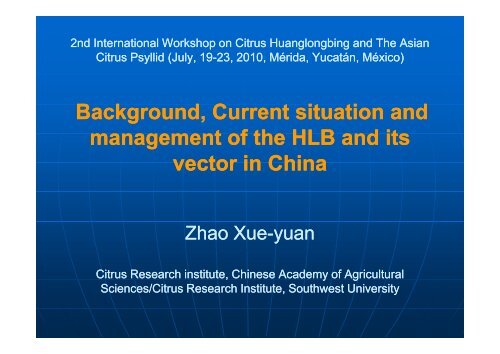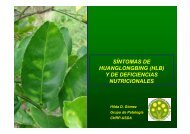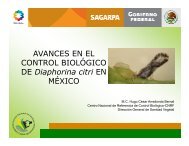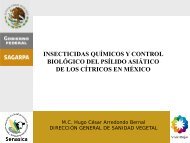Background, Current situation and management of the HLB and its ...
Background, Current situation and management of the HLB and its ...
Background, Current situation and management of the HLB and its ...
You also want an ePaper? Increase the reach of your titles
YUMPU automatically turns print PDFs into web optimized ePapers that Google loves.
2nd International Workshop on Citrus Huanglongbing <strong>and</strong> The Asian<br />
Citrus Psyllid (July, 19 19-23, 23, 2010, MMérida,<br />
rida, Yucat Yucatán, n, MMéxico)<br />
xico)<br />
<strong>Background</strong>, <strong>Current</strong> <strong>situation</strong> <strong>and</strong><br />
<strong>management</strong> <strong>of</strong> <strong>the</strong> <strong>HLB</strong> <strong>and</strong> <strong>its</strong><br />
vector in China<br />
Zhao Xue Xue-yuan yuan<br />
Citrus Research Research institute, Chinese Academy <strong>of</strong> Agricultural<br />
Sciences/Citrus Research Institute, Southwest University
Huanglongbing (<strong>HLB</strong>) means yellow shoot disease ,is a<br />
destructive disease prevailing in <strong>the</strong> sou<strong>the</strong>rn part <strong>of</strong> citrus<br />
producing area in China.<br />
According to old farmer’s memory, <strong>the</strong> history <strong>of</strong> <strong>its</strong><br />
occurrence is about 120 years, <strong>and</strong> <strong>the</strong> record history goes<br />
back to 1919.<br />
The graft transmissibility <strong>and</strong> virus nature <strong>of</strong> <strong>HLB</strong> was<br />
confirmed in <strong>the</strong> mid 1950’.<br />
Since 1960’, a group <strong>of</strong> isolated citrus nurseries were<br />
established for propagating <strong>HLB</strong> free budings.<br />
After <strong>the</strong> late 1970’, <strong>the</strong> strict control <strong>of</strong> citrus psyllid was<br />
emphasized in <strong>HLB</strong> control.<br />
In recent years, <strong>the</strong> <strong>HLB</strong> incidence was kept in low level<br />
in most citrus orchards, but it usually caused serious<br />
damage in o<strong>the</strong>rs o<strong>the</strong>rs.
1. Distribution <strong>and</strong> importance<br />
2. Symptom<br />
3. Causal agent<br />
4. Some characteristics <strong>of</strong> <strong>the</strong> pathogen in graft<br />
transmission<br />
5. Heat sensitivity<br />
6. Vector<br />
7. The relation between <strong>HLB</strong> prevalence <strong>and</strong><br />
environmental conditions<br />
8. Host<br />
9. Control
Distribution <strong>and</strong> importance
Citrus Cultivation <strong>and</strong> <strong>HLB</strong> Occurrence in <strong>the</strong> Mainl<strong>and</strong> <strong>of</strong> China
<strong>HLB</strong> prevailing area in China<br />
has a nor<strong>the</strong>rn “border”.<br />
The “border” is not stable.
In 1980’, <strong>the</strong>re was an apparent<br />
northward movement <strong>of</strong> <strong>HLB</strong> prevailing<br />
area occurred in Guangxi.<br />
Before 1980’, <strong>HLB</strong> prevalence had<br />
not been found in Nor<strong>the</strong>rn Guangxi,<br />
but in 1980’, <strong>the</strong> distribution <strong>of</strong> citrus<br />
psyllid was found <strong>and</strong> followed by <strong>HLB</strong><br />
epidemic (Zhou et al.,1989).
<strong>HLB</strong> Occurrence <strong>and</strong> Psyllid Distribution <strong>of</strong> Guangxi in Late 1970’
<strong>HLB</strong> Occurrence <strong>and</strong> Psyllid Distribution <strong>of</strong> Guangxi in Late 1980’
Since <strong>the</strong> early 2000’, <strong>the</strong><br />
northward movements <strong>of</strong> <strong>HLB</strong><br />
prevailing area have also<br />
occurred in Zhejiang, Hunan<br />
<strong>and</strong> Jiangxi Provinces.
In <strong>the</strong> area where citrus had not been<br />
planted, <strong>the</strong> young citrus orchards<br />
usually have a few trees shown <strong>HLB</strong><br />
symptoms in 22-3<br />
3 years after planting, if<br />
<strong>the</strong> psyllid was not controlled, <strong>the</strong><br />
incidence <strong>of</strong> <strong>HLB</strong> would quick increase,<br />
<strong>and</strong> <strong>the</strong> orchard would be destroyed in<br />
about 8 years after planting.
If <strong>the</strong> new orchard established close to<br />
<strong>the</strong> orchards with high <strong>HLB</strong> incidence, it<br />
would be destroyed by <strong>HLB</strong> in 11-3<br />
11-3<br />
3 years<br />
after planting.
Symptom
“Yellow shoot” <strong>and</strong> “mottling<br />
yellow leaf” are characteristic<br />
symptoms <strong>of</strong> <strong>HLB</strong>.
“Yellow shoot” shown in <strong>the</strong><br />
initial stage <strong>of</strong> <strong>the</strong> disease, new<br />
shoots <strong>of</strong> a part <strong>of</strong> <strong>the</strong> branches<br />
become yellowing, in summer or<br />
autumn, <strong>the</strong> yellow shoots<br />
usually appear first on <strong>the</strong> top <strong>of</strong><br />
<strong>the</strong> tree.
“Mottling yellow leaf ” is<br />
shown as <strong>the</strong> leaf mature, <strong>the</strong><br />
yellowing starts near <strong>the</strong> midrib,<br />
<strong>the</strong> lateral veins <strong>and</strong> leaf base.<br />
As <strong>the</strong> yellowing spreads, <strong>the</strong><br />
leaf shows a mottled pattern.
Most fru<strong>its</strong> <strong>of</strong> <strong>the</strong> diseased<br />
tree dropped earlier, <strong>the</strong> left<br />
fru<strong>its</strong> are small, poorly colored,<br />
shown “red nose” in some<br />
m<strong>and</strong>arins <strong>and</strong> being lopsided<br />
in some varieties.
“Red nose fruit”
New root growth is suppressed<br />
<strong>and</strong> <strong>the</strong> roots usually start decaying<br />
from <strong>the</strong> rootlets.
Causal agent
Several causes <strong>of</strong> <strong>HLB</strong> have been<br />
suggested:<br />
(1) water injury,<br />
(2) virus infection,<br />
(3) root rot caused by Fusarium sp.,<br />
(4) nutrient stress, <strong>and</strong><br />
(5) micro micro-elemental elemental deficiency.
The graft transmissibility <strong>and</strong> virus<br />
nature <strong>of</strong> <strong>HLB</strong> was confirmed in <strong>the</strong> mid<br />
1950’ (Lin, 1956).
In <strong>the</strong> early 1960’, <strong>the</strong>re was a dispute about<br />
whe<strong>the</strong>r <strong>the</strong> <strong>HLB</strong> virus is <strong>the</strong> same as tristeza virus<br />
or not.<br />
Chen et al. conducted an indicator test <strong>and</strong><br />
found that all <strong>of</strong> <strong>the</strong> <strong>HLB</strong> diseased trees were<br />
infected with tristeza virus, suggesting that <strong>HLB</strong><br />
should be caused by tristeza virus (Chen et al.1965)<br />
But according to <strong>the</strong> difference in host<br />
susceptibility, Lin suggested that <strong>HLB</strong> should not<br />
be caused by tristeza virus (Lin, 1977).
There after, indexing results revealed<br />
that some young seedlings in <strong>the</strong> field<br />
shown characteristic <strong>HLB</strong> symptoms<br />
were free <strong>of</strong> tristeza.<br />
Therefore, tristeza is an agent which<br />
usually infects citrus simultaneously with<br />
<strong>HLB</strong>, but it is not <strong>the</strong> actual cause <strong>of</strong><br />
<strong>HLB</strong> (Zhao et al.,1979).
Tetracyclin sensitivity <strong>of</strong> <strong>the</strong> causal<br />
agent <strong>of</strong> <strong>HLB</strong> was revealed by<br />
budwood dipping <strong>and</strong> trunk injection in<br />
<strong>the</strong> mid 1970’ (Kwangxi Citrus Yellow Shoot Study<br />
Group,1975).<br />
The tetracycline sensitivity <strong>of</strong> <strong>HLB</strong><br />
pathogen indirectly proved that <strong>HLB</strong> is<br />
caused by mycoplasma<br />
mycoplasma-like like organism<br />
but not by virus.
After <strong>the</strong> electron<br />
microscopic<br />
examinations<br />
examinations, , Ke et al.<br />
suggested that <strong>the</strong><br />
causal agent <strong>of</strong> <strong>HLB</strong><br />
may belong in <strong>the</strong><br />
rickettsia rickettsia-like like organism<br />
(Ke et al., 1979) <strong>and</strong> Chen et<br />
al. suggested that <strong>the</strong><br />
causal agent <strong>of</strong> <strong>HLB</strong><br />
may be a new type <strong>of</strong><br />
mycoplasma<br />
mycoplasma-like like<br />
organism (Chen et al., 1979a;<br />
Chen et al.,1979b).
Afterwards, <strong>the</strong> results <strong>of</strong><br />
PCR test revealed that <strong>HLB</strong><br />
is caused by C<strong>and</strong>idatus<br />
Liberibacter asiaticus.
Recently, Chen et al. discovered a<br />
phytoplasma related to C<strong>and</strong>idatus<br />
Phytoplasma asteri in some leaf<br />
samples shown <strong>HLB</strong> symptoms<br />
collected in Guangdong (Chen et al., 2009).
Some characteristics <strong>of</strong> <strong>HLB</strong> in<br />
graft transmission
Incubation period after graft<br />
inoculation in young seedlings is<br />
2-9 9 months.
As 1-16 16 years old m<strong>and</strong>arin trees<br />
were graft inoculated in September,<br />
most <strong>of</strong> <strong>the</strong> trees shown symptoms<br />
on <strong>the</strong> inoculated branch in 7-9 9<br />
months after inoculation (Lin, 1963).
The graft transmissibility <strong>and</strong><br />
<strong>the</strong> <strong>HLB</strong> incidence <strong>of</strong> <strong>the</strong><br />
progeny plants <strong>of</strong> a diseased<br />
tree is variable <strong>and</strong> never<br />
reaches 100% (Lin, 1956; Kao et al.,1963;<br />
Zhao et al., 1982). It shows that <strong>the</strong><br />
distribution <strong>of</strong> <strong>the</strong> pathogen in<br />
host plant might be uneven.
Graft transmissibility influenced by <strong>the</strong><br />
tissue used for inoculum. As different tissue<br />
from <strong>the</strong> same diseased budwood were<br />
used as inoculum, <strong>the</strong> transmissibility is<br />
different as follows: single bud bud, , 22/26 (85%);<br />
piece <strong>of</strong> stem without bud bud, bud bud, , 29/43 (67%);<br />
piece <strong>of</strong> stem bark bark,2/43 ,2/43 (5%).<br />
Above data indicated that <strong>the</strong> graft<br />
transmissibility by bark as inoculum is much<br />
lower than that by <strong>the</strong> o<strong>the</strong>r tissues (Zhao et al.<br />
1982).
As <strong>the</strong> budwoods collected<br />
from <strong>the</strong> same diseased tree<br />
are propagated in different<br />
seasons, <strong>the</strong> <strong>HLB</strong> incidence <strong>of</strong><br />
<strong>the</strong> progeny plants is quite<br />
different.
No. plants diseased/<br />
Grafting season No. plants grafted Percentage<br />
Test 1<br />
1976 1976-Nov. Nov. 21/30 70.0<br />
1977 1977-Jan. Jan. 6/14 42.9<br />
-Mar. Mar. 6/8 75.0<br />
-May May 1/21 4.8<br />
-Jul. Jul. 0/22 0.0<br />
-Sept. Sept. 2/15 13.3<br />
Test 2<br />
1979 1979-Feb. Feb. 29/30 96.7<br />
-Apr. Apr. 14/20 70.0<br />
-Jun. Jun. 1/9 11.1<br />
-Aug. Aug. 6/9 66.7<br />
-Oct. Oct. 18/19 94.7<br />
-Dec. Dec. 18/22 81.8<br />
1980 1980-Feb. Feb. 24/25 96.0<br />
-Jun. Jun. 4/27 14.8
Above data indicated that<br />
<strong>HLB</strong> incidence <strong>of</strong> <strong>the</strong> progeny<br />
plants propagated in hot<br />
seasons is much lower than<br />
that propagated in o<strong>the</strong>r<br />
seasons ( Zhao<br />
( Zhao et al al.,1982 .,1982 )
Heat sensitivity
Lin et al al. . (1965) reported that 33-yr.<br />
yr.<br />
-old old Tankan m<strong>and</strong>arin affected with<br />
<strong>HLB</strong> recovered normal growth after<br />
treatments for 45-65 45 65 min in 48 48-50 50℃ ℃<br />
moist air air, , <strong>and</strong> for 35-55 35 55 min in 51 51℃ ℃<br />
moist air air. air air.<br />
Lo et al al. . (1981) fur<strong>the</strong>r proved that<br />
diseased budlings recovered normal<br />
growth after moist air treatment for 50<br />
min at 49 49℃ or 50 50℃.
Lo (1983) reported that<br />
budwoods collected from<br />
diseased tree could be sterilized<br />
by immercing in 47 water for<br />
10 min <strong>and</strong> repeat twice with <strong>the</strong><br />
interval <strong>of</strong> 24 hours.
Vector
The transmission<br />
<strong>of</strong> <strong>HLB</strong> by<br />
citrus psyllid<br />
(Diaphorina Diaphorina citri<br />
Kuw.) was<br />
experimentally<br />
confirmed in <strong>the</strong><br />
mid 1970 1970’.
Under experimental condition, <strong>the</strong><br />
transmissibility <strong>of</strong> <strong>HLB</strong> by psyllid was relative low.<br />
The tests carried out in Liuzhou, Guangxi in<br />
1973 1973-78, 78, healthy caged seedlings were exposed to<br />
<strong>the</strong> psyllid collected from diseased trees in <strong>the</strong> field,<br />
50-200 50 200 adults were released per caged plant.<br />
Thirty two <strong>of</strong> 398 plants ( 8.0 %) developed <strong>HLB</strong><br />
symptoms (Chao et al.,1979).<br />
The tests carried out in Fuzhou, Fujian in 1978 1978-<br />
1984. 40 <strong>of</strong> 329 plants (12.2%) developed <strong>HLB</strong><br />
symptoms. Similar tests carried in Raoping,<br />
Guangdong in 1982 1982-1984, 1984, 33 <strong>of</strong> 70 plants (47.1%)<br />
developed <strong>HLB</strong> symptoms (Xu et al.1985).
Young seedlings could be<br />
infected by <strong>HLB</strong> after feeding by<br />
only one psyllid adult (Xu, 1988). The<br />
minimum incubation period <strong>of</strong><br />
<strong>of</strong><br />
young seedlings after psyllid<br />
inoculation is 2 months <strong>and</strong> 5-8 8<br />
months in general.
<strong>HLB</strong> could be transmitted by<br />
4th-5th 4th 5th instar numph <strong>of</strong> <strong>the</strong><br />
psyllid <strong>and</strong> by just emerged<br />
adult, but not by 1st 1st-3rd 3rd instar<br />
nymph (Xu, 1988 ).
The relation between <strong>HLB</strong> prevalence<br />
<strong>and</strong><br />
environmental conditions
In <strong>the</strong> early 1960’, Kao et al al. .<br />
surveyed <strong>the</strong> occurrence <strong>of</strong> <strong>HLB</strong><br />
in Fujian <strong>and</strong> indicated that<br />
suppressive conditions for <strong>HLB</strong><br />
may exist in <strong>the</strong> districts with<br />
high latitude or high altitude (Kao et<br />
al. 1963).
A survey <strong>of</strong> 27 counties in Guangxi<br />
was made in 1973 1973-1977,<strong>and</strong> 1977,<strong>and</strong> found<br />
that <strong>the</strong>re was no natural spread <strong>of</strong><br />
<strong>HLB</strong> in <strong>the</strong> nor<strong>the</strong>rn part <strong>of</strong> Guangxi<br />
where <strong>the</strong> psyllid was not found, <strong>and</strong><br />
usually <strong>the</strong>re was a high population <strong>of</strong><br />
psyllid in <strong>the</strong> sou<strong>the</strong>rn part where <strong>HLB</strong><br />
was epidemic (Chao et al., 1979).
The Sichuan Citrus Huanglongbing Survey Group (1977)<br />
reported that <strong>the</strong> incidence <strong>of</strong> <strong>HLB</strong> was different in <strong>the</strong><br />
orchards with different altitude near Jule commune in<br />
Ningnan county.<br />
Orchard Altitude (m) Psyllid population <strong>HLB</strong> incidence<br />
1 1090 abundant nearly 100 %<br />
2 1200 abundant nearly 100 %<br />
3 1210 exist 40 %<br />
4 1385 not found 3.6 %<br />
5 1420 not found 3.0 %<br />
6 1500 not found 3.0 %<br />
7 1620 not found 3.0 %
A survey conducted in 1977 in <strong>the</strong> farm<br />
<strong>of</strong> Red Flag commune in Wuzhou, Guangxi<br />
revealed that in <strong>the</strong> orchard located in a<br />
valley, <strong>the</strong> budlings were planted in 1965, no<br />
psyllid was found, 3 <strong>of</strong> 80 trees shown <strong>HLB</strong><br />
symptoms, on <strong>the</strong> o<strong>the</strong>r h<strong>and</strong>, in <strong>the</strong> orchard<br />
outside <strong>of</strong> <strong>the</strong> valley, also planted in 1965,<br />
with <strong>the</strong> budlings have <strong>the</strong> same source as<br />
<strong>the</strong> budlings planted in <strong>the</strong> valley, psyllid<br />
population was high, nearly all <strong>of</strong> <strong>the</strong> trees<br />
were destroyed by <strong>HLB</strong> (Chao et al., 1979).
Above <strong>situation</strong> indicated that<br />
<strong>the</strong> environmental conditions<br />
directly influenced <strong>the</strong> distribution<br />
<strong>of</strong> psyllid, as well as inference <strong>the</strong><br />
<strong>HLB</strong> prevalence.
Before 1980’, in order to increase<br />
<strong>HLB</strong> tolerance, experiments had been<br />
conducted to improve <strong>the</strong> nutrient<br />
<strong>situation</strong> <strong>of</strong> citrus plant by fertilization,<br />
irrigation <strong>and</strong> soil improvement.<br />
No positive results had been<br />
obtained.
Host
In <strong>the</strong> general survey, all <strong>of</strong> <strong>the</strong><br />
varieties <strong>of</strong> genus Citrus <strong>and</strong> Fortunella<br />
are susceptible to <strong>HLB</strong> <strong>HLB</strong>, , trifoliate orange<br />
is tolerant.<br />
Murraya paniculata <strong>and</strong> Clausena<br />
lansium have been identified to be<br />
infected in <strong>the</strong> field by C<strong>and</strong>idatus<br />
Liberibacter asiaticus ( Li et al.,2002; Ding et al.,2005;<br />
Deng et al.,2007).
Control
1. Quarantine.<br />
<strong>HLB</strong> was defined as a target <strong>of</strong> plant<br />
quarantine by <strong>the</strong> Department <strong>of</strong><br />
Agriculture in 1957.<br />
A national st<strong>and</strong>ard was issued in 1985. It is<br />
a guideline for producing <strong>HLB</strong> free <strong>and</strong><br />
citrus canker free budlings.
2. Diagnosis<br />
Diagnosis. .<br />
Since <strong>the</strong> late 1950 1950’, , mottling yellow leaf is<br />
commonly used as main criterion for <strong>HLB</strong><br />
diagnosis in <strong>the</strong> field (Kao et al.,1958; Kao et al.,1959),<br />
since 1990 1990’, , PCR has been used for <strong>the</strong> exact<br />
diagnosis <strong>of</strong> <strong>HLB</strong> <strong>HLB</strong>(Tian Tian et al.,1996)<br />
In general, <strong>HLB</strong><br />
diagnosis is completed<br />
in <strong>the</strong> field by finding<br />
mottling yellow leaf,<br />
<strong>and</strong> in <strong>the</strong> new<br />
prevailing area, PCR is<br />
also practiced.
3. Producing <strong>and</strong> planting <strong>HLB</strong> free<br />
budlings budlings.<br />
In <strong>the</strong> past, <strong>the</strong> site <strong>of</strong> mo<strong>the</strong>r block <strong>and</strong><br />
nursery should be established in a<br />
separated area, 1.5 1.5-3 1.5 1.5-3 3 km apart from exist<br />
citrus orchards. In recent years, a part <strong>of</strong><br />
mo<strong>the</strong>r block <strong>and</strong> nursery are established in<br />
screen house.
The budwoods are collected<br />
from <strong>HLB</strong> free area, or from healthy<br />
trees st<strong>and</strong>ing in <strong>the</strong> orchards with<br />
low <strong>HLB</strong> incidence, <strong>and</strong> treated by<br />
tetracycline immersing or<br />
intermittent heat treatment.
The exclusion <strong>of</strong> <strong>HLB</strong> by shoot shoot-tip tip<br />
grafting was experimentally confirmed in<br />
1987 (Jiang et al., 1987; Chen et al., 1987 ).<br />
Accompanied with o<strong>the</strong>r diseases<br />
control, shoot shoot-tip tip grafting is used for<br />
preparing <strong>HLB</strong> free mo<strong>the</strong>r plants.
4. Psyllid control control.<br />
Strictly control psyllid in a large area by<br />
insecticides is <strong>the</strong> most important procedure for<br />
<strong>HLB</strong> control control. .<br />
In general, <strong>the</strong>re are 11-2<br />
2 insecticide sprays in<br />
<strong>the</strong> period between after picking <strong>and</strong> before spring<br />
sprout, <strong>and</strong> each 11-2<br />
11-2<br />
2 sprays in spring, summer <strong>and</strong><br />
autumn growth period.<br />
Organic phosphorus insecticides are usually<br />
used, in recent years, o<strong>the</strong>r than chlorpyrifos,<br />
phoxim etc. imidacloprid <strong>and</strong> thiamethoxam<br />
(Actara) are also used.
5. Remove diseased plants plants.<br />
Remove diseased plants promptly is<br />
also an important procedure for <strong>HLB</strong><br />
control control. .<br />
In general, <strong>the</strong> diseased plants are<br />
removed after picking, in some farms,<br />
removing <strong>the</strong> diseased plants 3 times<br />
per year is practiced.
Serious damage caused by <strong>HLB</strong><br />
<strong>and</strong> <strong>the</strong> <strong>management</strong> <strong>of</strong> <strong>HLB</strong><br />
accelerated <strong>the</strong> development <strong>of</strong> citrus<br />
production in <strong>the</strong> Yangcun Citrus farm farm, ,<br />
Guangdong is a representative example<br />
<strong>of</strong> <strong>HLB</strong> control (Zhuang, 1987).
Yangcun Citrus Farm was <strong>the</strong><br />
biggest national citrus farm in last<br />
century with <strong>the</strong> acreage <strong>of</strong> 1300 1300-<br />
2000 ha.
Citrus planting was began in 1953. In<br />
1953 1953-1972 1972, , for <strong>the</strong> control <strong>of</strong> leaf rollers, leaf<br />
minor, geometrid <strong>and</strong> red mite, organic<br />
chloride <strong>and</strong> organic phosphorus insecticides<br />
were sprayed several times per year, psyllid<br />
was very difficult to be found, <strong>the</strong> annual<br />
incidence <strong>of</strong> <strong>HLB</strong> was not more than 1%, <strong>the</strong><br />
citrus production developed successfully in<br />
that period.
Since 1974 1974, , leaf rollers <strong>and</strong> geometrid<br />
were controlled <strong>and</strong> organic chlorides were<br />
eliminated to be used, insecticides effective<br />
for psyllid were less sprayed, <strong>the</strong> psyllid<br />
population significantly increased <strong>and</strong><br />
followed by high incidence <strong>of</strong> <strong>HLB</strong> in 1978 1978-<br />
1982. Up to 1982, all <strong>of</strong> 960 thous<strong>and</strong> trees<br />
planted before 1972 had been destroyed.
Since December, 1978, psyllid control was<br />
enhanced, 2 sprays <strong>of</strong> organic phosphorus after<br />
fruit picking <strong>and</strong> before before spring spring sprouting, each 1 or<br />
2 sprays in spring, summer <strong>and</strong> autumn growth<br />
period. O<strong>the</strong>r than psyllid control, all <strong>of</strong> <strong>the</strong> trees<br />
shown <strong>HLB</strong> symptoms removed 3 times in each<br />
year.<br />
There after, <strong>the</strong> psyllid population significantly<br />
decreased, <strong>the</strong> incidence <strong>of</strong> <strong>HLB</strong> was 6.8% in<br />
1978, 1.3 1.3-3.8% 3.8% in 1979 1979-1982, 1982, <strong>and</strong> less than 1% in<br />
1983 1983-1992 1992. . The citrus production developed<br />
smoothly in 1983 -1992. 1992.
Since 1993 1993, , <strong>the</strong> <strong>management</strong><br />
system <strong>of</strong> <strong>the</strong> farm changed, technical<br />
procedures were decided by producer<br />
<strong>the</strong>mselves, but not by farm manager<br />
<strong>and</strong> technicians, <strong>and</strong> less amount <strong>of</strong><br />
insecticides were applied. Hence, <strong>the</strong><br />
psyllid population <strong>and</strong> <strong>HLB</strong> incidence<br />
increased again again.
The <strong>situation</strong> similar with “Yangcun<br />
Experience” has appeared in different<br />
localities. Since <strong>the</strong> early 2000’ much<br />
extension works for <strong>HLB</strong> control has been<br />
done by <strong>the</strong> Agricultural Department <strong>of</strong><br />
Provincial Government in Zhejiang, Guangxi,<br />
Fujian (Yongchun) <strong>and</strong> Guizhou (Congjiang),<br />
<strong>and</strong> <strong>the</strong> quick spread <strong>of</strong> <strong>HLB</strong> in those areas<br />
was checked.
Thank you for your attention!





